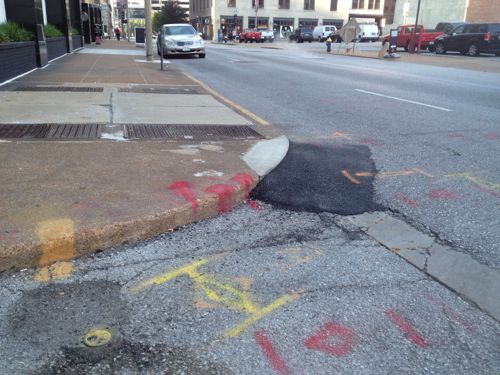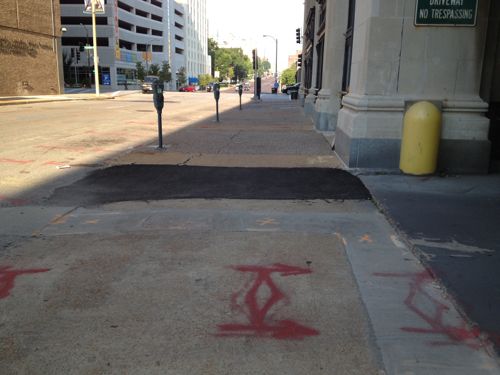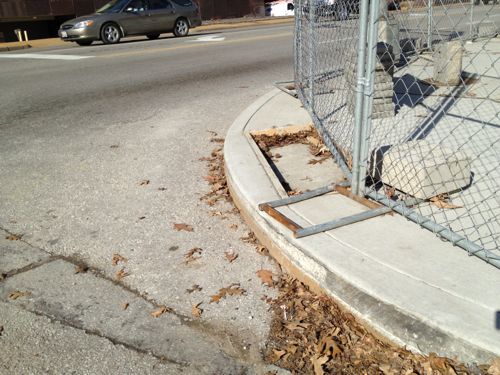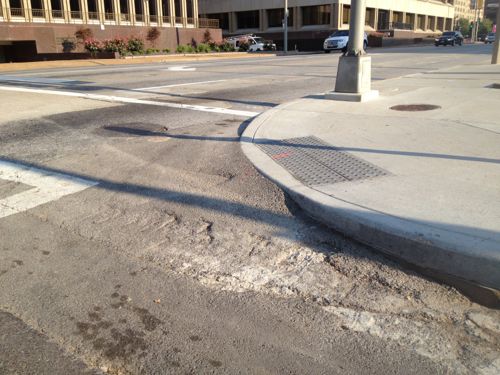Asphalt Accessibility
Recently I defended the city’s planned use of asphalt to bridge the gap between a sidewalk that sank next to a water main lid (see post). One comment started an interesting side thread: “Then let’s do this at every intersection that lacks a curb ramp!”
So today I’m going to show you uses of asphalt that are both acceptable & unacceptable, and try to explain the difference.
Acceptable


In both cases it looks like a half-ass fix, because they are. When you have very little money you must often make due. These weren’t ADA-compliant before and they still aren’t now. In both cases though, I can now get through where I couldn’t before.
Unacceptable


This case is like the step at Park Pacific across the street, a major project with new concrete that ended up non-compliant. Not only was this poured inches above the street level, it is pointing into the intersection. This corner should’ve had one directional ramp for 14th and another for Olive. The other ramps around the library have similar problems.
If I had to chose between non-ADA compliant where I had to pick another route or non-ADA compliant where I (and others) can still get through I’ll always pick the latter. Just as I’ll always expect new work to be done correctly.
— Steve Patterson
While I basically agree with your conclusions, they avoid the two fundamental issues, both money related. One, the ADA is now 23 years old. The DOJ regulations are clear – the city needs to make ALL sidewalks accessible / compliant within a “reasonable” time frame. Two decades later, it’s still far from complete. Yes it costs money. Other cities have found the money – why has St. Louis failed to do so? And two, if money truly is the issue, then why not default to the “half-assed” option and get more of the city accessible? As you well know, any path of travel is only as good as its weakest link. If waiting for perfect / correct means waiting for fifty plus years to get the city done, is that truly the best answer?
§35.150 Existing facilities.
(d) Transition plan. (1) In the event that structural changes
to facilities will be undertaken to achieve program accessibility, a public
entity that employs 50 or more persons shall develop, within six months of the
effective date of this part, a transition plan setting forth the steps necessary
to complete such changes. A public entity shall provide an opportunity to
interested persons, including individuals with disabilities or organizations
representing individuals with disabilities, to participate in the development
of the transition plan by submitting comments. A copy of the transition plan
shall be made available for public inspection.
(2) If a public entity has responsibility or authority over streets,
roads, or walkways, its transition plan shall include a schedule for providing
curb ramps or other sloped areas where pedestrian walks cross curbs, giving
priority to walkways serving entities covered by the Act, including State and
local government offices and facilities, transportation, places of public
accommodation, and employers, followed by walkways serving other areas.
(3) The plan shall, at a minimum —
(i) Identify physical obstacles in the public entity’s facilities that
limit the accessibility of its programs or activities to individuals with
disabilities;
(ii) Describe in detail the methods that will be used to make the
facilities accessible;
(iii) Specify the schedule for taking the steps necessary to achieve
compliance with this section and, if the time period of the transition plan is
longer than one year, identify steps that will be taken during each year of the
transition period; and
(iv) Indicate the official responsible for implementation of the plan.